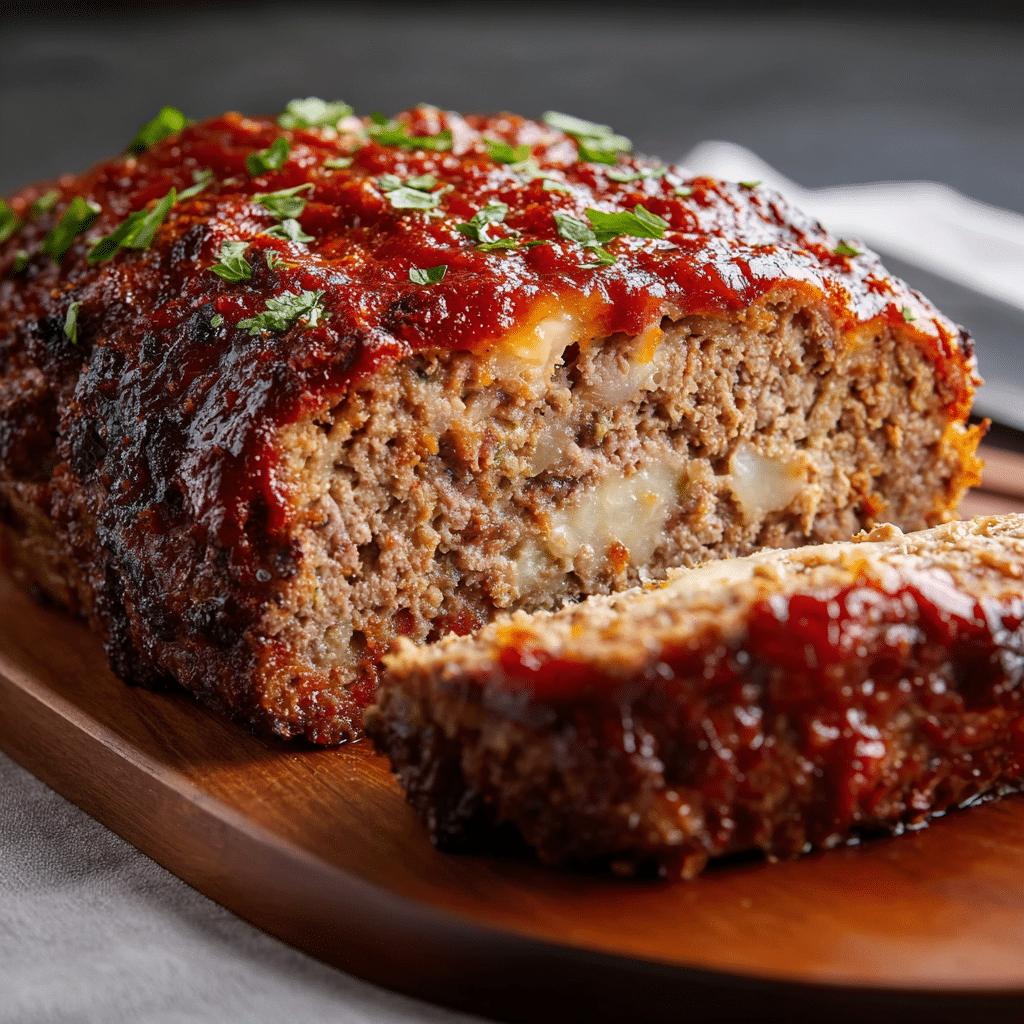The Sicilian Meatloaf, or Polpettone Siciliano, is a stunning centerpiece for any meal. The layers of prosciutto, provolone, and greens create a beautiful mosaic when sliced, showcasing the rich flavors within.
This dish is not only visually appealing but also versatile. It can be served warm as a main course or chilled for a refreshing antipasto. Pair it with a crisp white wine and a simple salad for a complete Italian-inspired meal.
Full Recipe
Ingredients:
-
5 slices firm white sandwich bread (about 4½ ounces/125 g)
-
2 tablespoons whole milk
-
2¼ pounds (1 kg) ground beef or a mixture of ground beef and ground pork
-
4 large eggs
-
1 small yellow onion, very finely chopped or grated
-
1 cup (120 g) finely grated Parmigiano-Reggiano or pecorino cheese
-
1 tablespoon finely chopped fresh flat-leaf parsley leaves
-
1 tablespoon finely chopped fresh mint
-
2 teaspoons fine sea salt
-
1 teaspoon freshly ground black pepper
For Assembly:
-
3½ ounces (100 g) prosciutto cotto or boiled ham, very thinly sliced
-
½ cup (100 g) boiled, drained, and chopped mustard greens, Swiss chard, or spinach
-
3½ ounces (100 g) mild provolone cheese or primo sale, very thinly sliced
-
4 large hard-boiled eggs, peeled
Directions:
-
Preheat the oven to 350°F (180°C). Line a large sheet pan with parchment paper.
-
For the meatloaf mixture: Cut off and discard the crusts of the sandwich bread. Cut the bread into small cubes and place in a large bowl. Sprinkle the milk on top and toss to combine. Let sit for 5 minutes to soften.
-
Add the ground beef, eggs, onion, Parmigiano, parsley, mint, salt, and pepper to the moistened bread. Using your hands, knead and squeeze the ingredients together until they are thoroughly incorporated.
-
For assembly: Gather up the meat mixture and place it on a large sheet of parchment paper. Use your hands to flatten the mixture into a 12-by-16-inch (30 by 40 cm) rectangle about ½ inch (1 cm) thick. Set the rectangle with a long side facing you.
-
Lay the ham slices over the meat mixture, covering it almost completely from edge to edge. Distribute the cooked greens evenly over the ham and then top with the cheese slices. Place the hard-boiled eggs end to end in a row running lengthwise down the center. Using the parchment paper to help, lift and wrap the meat, like a jelly roll, over the eggs, and keep rolling until it forms a large sausage. Press the ends together to seal the fillings inside. Transfer the meatloaf to the prepared sheet pan, discarding the parchment used to roll it.
-
Bake the meatloaf for 30 minutes. Increase the oven temperature to 475°F (250°C) and roast until the outside is browned, 5 to 10 minutes. Remove from the oven and let rest for a few minutes before slicing.
-
Arrange the slices on a platter and serve hot or at room temperature.
Prep Time: 30 minutes
Cooking Time: 35 minutes
Total Time: 1 hour 5 minutes
Kcal: Approximately 600 kcal per serving
Servings: 6 servings
Origins of Sicilian Meatloaf (Polpettone Siciliano)
Sicilian Meatloaf, known in Italian as Polpettone Siciliano, is a traditional dish deeply rooted in the heart of Southern Italy. This dish exemplifies the culinary ingenuity of Sicilian home cooks who mastered the art of turning humble ingredients into rich, flavorful meals. As with many Italian classics, the origins of polpettone are steeped in regional pride and family tradition, with each household boasting its own unique twist on the recipe.
Unlike the American-style meatloaf, which is typically baked in a loaf pan and often includes ketchup or a tomato glaze, Sicilian meatloaf is stuffed and rolled like a jelly roll, then baked to golden perfection. It’s a celebration dish, often served during Sunday family lunches or festive gatherings. Its filling—commonly made with prosciutto cotto, provolone cheese, and seasonal greens—reflects the island’s Mediterranean influence and resourcefulness. It’s both comforting and refined, rustic yet elegant.
Cultural Significance and Family Tradition
The Sicilian meatloaf isn’t just food; it’s a vessel of cultural transmission. In Sicilian families, recipes like this are handed down from generation to generation, often without a written format. The process of preparing polpettone is almost ritualistic, bringing families together to bond, share stories, and create memories. In many homes, children are given the role of helping to assemble the meatloaf—laying out the slices of ham, helping to roll the meat, or even peeling the hard-boiled eggs for the filling.
Its versatility also means that it can serve as a symbol of hospitality. Whether it’s served hot at a dinner table or sliced cold for antipasti, it’s a dish that encourages sharing. In fact, slicing into a Sicilian meatloaf reveals a stunning cross-section that’s almost mosaic-like, with layers of vibrant ingredients symbolizing abundance and togetherness.
What Makes Sicilian Meatloaf Unique
What truly sets Polpettone Siciliano apart is its filling. While standard meatloaf recipes may be heavy and one-note, the Sicilian version is all about contrast—soft and tender meat on the outside, with a surprising and colorful filling inside. The addition of hard-boiled eggs running down the center is not just for taste; it adds structure and visual appeal, creating a “bullseye” effect when sliced.
Another distinctive feature is the layering of Italian deli meats like prosciutto cotto and the use of semi-soft cheeses such as provolone or primo sale. Combined with cooked greens—such as spinach, mustard greens, or Swiss chard—this brings both a savory depth and a slight bitterness that cuts through the richness of the meat and cheese.
Sicilian cuisine is known for using simple ingredients in inventive ways, and this meatloaf is no exception. Fresh herbs like parsley and mint bring brightness to the ground meat mixture, and finely grated cheese within the meat base ensures that every bite is packed with flavor.
Ideal Occasions to Serve It
Polpettone Siciliano is incredibly versatile and can be served on a variety of occasions. Its appearance and flavor make it a strong contender for festive holidays such as Easter, Christmas, or family reunions. Because it’s equally delicious hot or at room temperature, it also works beautifully for potlucks and picnic-style meals.
The dish also holds its own as a weeknight dinner when you’re craving something cozy yet elevated. It pairs beautifully with simple sides like roasted potatoes, garlic sautéed greens, or a crisp fennel salad. In some Sicilian homes, it’s common to serve the meatloaf with a rustic tomato sauce or a drizzle of good olive oil to keep the meat moist and flavorful.
Pairings and Wine Suggestions
Sicilian meatloaf pairs best with medium-bodied red wines that complement its earthy and savory profile. A good Nero d’Avola—the flagship red wine of Sicily—makes a natural pairing. With its dark fruit notes and subtle spice, it stands up beautifully to the richness of the meat and cheese.
If you prefer white wine, opt for something with structure and acidity like a Grillo or Inzolia, also native to Sicily. These wines balance the richness of the meatloaf while highlighting the herbaceous and vegetal notes of the greens inside. For non-alcoholic options, sparkling water with lemon or a light iced herbal tea offers a refreshing counterpoint to the heartiness of the dish.
Tips for Perfecting Polpettone Siciliano
To make an excellent Sicilian meatloaf, texture and moisture control are key. Start by using a mix of ground beef and pork for optimal flavor and fat content. Overworking the meat mixture can make it dense, so mix it just enough to combine the ingredients thoroughly.
For the filling, be sure to drain the cooked greens well to prevent excess moisture from seeping into the loaf and breaking it apart during baking. Chilling the rolled meatloaf for about 20 minutes before baking can help it hold its shape better and ensure even cooking.
Baking the meatloaf uncovered allows it to develop a delicious crust on the outside, while the inside remains juicy. A final blast of high heat helps achieve that golden brown finish that is both visually striking and flavorful.
Storage and Leftovers
One of the most practical aspects of Sicilian meatloaf is how well it stores. Leftovers can be refrigerated for up to 4 days and are excellent served cold in sandwiches or warmed up with a splash of broth or tomato sauce. It also freezes well, either whole or sliced, making it a great make-ahead option for busy families or meal preppers.
Sliced thin, it also makes an elegant appetizer when served on crostini or as part of a charcuterie board. You can even cube leftover pieces and toss them into pasta or a frittata, adding a boost of flavor and protein to other meals.
Modern Twists and Variations
Though the classic version is timeless, modern cooks have started experimenting with variations to suit dietary preferences and creativity. For a lighter version, turkey or chicken can be substituted for the beef and pork, and low-fat cheese can be used. Vegetarians have even reimagined polpettone using lentils, beans, and plant-based meats, maintaining the same rolling and filling method for presentation.
Another popular tweak is to add nuts like pine nuts or pistachios to the filling for a bit of crunch and added Sicilian flair. Sun-dried tomatoes and roasted red peppers also make flavorful additions that enhance the visual appeal of the slices.
Why You Should Try This Dish
Sicilian meatloaf is more than just a comfort food—it’s an experience. From its aroma that fills your kitchen as it bakes, to the way it slices open to reveal a surprise of textures and colors, every element is crafted to bring joy. It’s a dish that impresses without being overly complicated and delivers hearty, satisfying flavor in every bite.
Moreover, it allows you to engage with the rich culinary heritage of Sicily. Making this dish is a way to slow down, cook with intention, and nourish those you love. It brings people together around the table, sparking conversations and leaving a lasting impression long after the plates have been cleared.
Conclusion
Sicilian Meatloaf, or Polpettone Siciliano, is a true embodiment of Southern Italian cooking—humble in its roots yet elevated in execution. With its hearty meat base, flavorful fillings, and beautiful presentation, it offers a multi-sensory dining experience that’s perfect for both everyday meals and special occasions. Its adaptability, storability, and deep cultural resonance make it a must-have recipe in any food lover’s repertoire. Whether you follow the traditional method or add your own spin, this dish invites you to embrace the art of cooking with heart and heritage.






